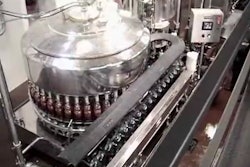“The integration of business and manufacturing has a strategic importance for Arla Foods in supporting the challenges the business is facing in terms of optimizing production performance, as well as fulfilling food safety regulatory requirements,” says Arne Svendsen, production IT manager at Arla Foods. “This integration includes the transfer of detailed production schedules from our ERP (Enterprise Resource Planning) system to the plant floor, as well as the seamless collection of key processing and packaging figures.”
A firm believer in standards, Svendsen has been influential in helping SAP AG to “discover” the plant floor. As the leading supplier of ERP systems in the world, SAP, based in Walldorf, Germany, until recently did not offer an application solution that permitted true Business-to-Manufacturing (B2M) integration. But with packaged goods companies around the world—Arla among them—seeking a better B2M integration solution, SAP recently introduced NetWeaver in a version that supports the Instrumentation Systems and Automation Society standard S95 eXtensible Markup Language (XML). Involving what IT experts call “wraparound” software, it turns SAP’s R3 ERP product into one that is fully compatible with ISA S95 XML standards.
With this initiative, SAP asked itself “How do we achieve standards-based interfaces to our systems? How do we ensure that if a production order’s path from ERP to the plant floor needs to pass through Wonderware or Rockwell or Siemens components, it won’t require three separate interfaces?” The answer: S95 compatibility.
“What we have learned,” said SAP Senior Vice President Stefan Schaffer in a recent interview with Greg Gorbach, of the ARC Advisory Group, Dedham, Mass.,“is that there are already defined standards that really fulfill the customer’s needs. It’s a much better business case for all the participants to use these well-thought-through standards than to create new ones.”
The first implementation of SAP NetWeaver in its S95-based format is scheduled to unfold this May at Arla Foods’ Vimmerby plant in Sweden. Here, powdered milk is packaged for industrial customers in bags ranging from 10 to 1ꯠ kilograms.
“With this NetWeaver implementation, we will be able to transmit production orders from the ERP down to processing and packaging machines and transmit data back up again,” says Svendsen. “To achieve that degree of integration in the past, we’ve had to develop custom-made solutions using the very first versions of B2MML (Business-to-Manufacturing Markup Language) schema from the World Batch Forum. Because NetWeaver uses an open standard, ISA S95, we no longer need to come up with custom-made integration solutions.”
Tim Sowell, vice president of product strategy at Wonderware, notes, “Everybody wants the same two-way street: Production schedules down, production performance data up. And while it’s possible to achieve this with point-to-point solutions, they aren’t easily maintained and they aren’t very scaleable.
“Another difficulty is if vendors upgrade any of their application software, the interfaces in a custom-made integration scheme stand a good chance of breaking down. But if the interfaces are all built on a standard like S95, then it’s clearly the responsibility of the vendor to test those interfaces to guard against a breakdown.”
Benefits gained at Arla’s newly integrated Vimmerby plant will include reduced man-hours, the ensured integrity of information flow both down from the ERP system and back up from the plant floor, and an increased capacity to meet marketplace needs quickly. Explains Arla’s Svendsen. “Now that information will be transmitted directly and automatically from the ERP to the packaging machine, it not only reduces time spent by the operator, it reduces the chance for errors during order reentry.”
Throughout the 60 or so manufacturing sites that Arla operates, plant intelligence systems from Wonderware, Lake Forest, Calif., are expected to pay big dividends. Wonderware’s DT Analyst, for example, should help improve Overall Equipment Efficiency (OEE), says Arla Production Manager Eric Veslov.
OEE is built on the assumption that the overall efficiency of equipment will always be governed by the cumulative impact of three factors: equipment availability, equipment performance rate, and quality of goods produced. DT Analyst is an out-of-the-box reporting system that delivers a simple OEE solution that will help Arla drive machine efficiency improvements on the plant floor and report back through the organization—all the way to Arla’s corporate headquarters.
“Using DT Analyst and the OEE concept, we expect to improve competitiveness and utilization of machinery,” Veslov says. “We’ll use it for continuous improvement of efficiency including improving uptimes, reducing downtimes, and expanding employee involvement in making such improvements possible.”
Production IT Manager Svendsen is another believer in the benefits that can be achieved through DT Analyst. Says Svendsen, “DT Analyst will help us measure machine efficiencies with a common ruler across multiple sites. We’ll be able to benchmark more effectively because the same KPI (Key Performance Indicator) calculation model will be applied across all sites.”
“Not only do we want to calculate OEE, we want it plainly visible in real time to everybody,” says Svendsen. “We want automated data collection and we want it done according to corporate standards, so that every machinery OEM understands that we want a data plot on top of their machine control.”
Svendsen also aims to involve Arla in the work being done jointly by the World Batch Forum and the Open Modular Architecture Controls (OMAC) Packaging Workgroup. Called Make2Pack, this group seeks ways of more tightly integrating processing and packaging.
Arla’s ultimate goal is to knit nearly 18ꯠ employees in some 60 milk, cheese, and milk powder plants around the world into a single, focused entity.


























